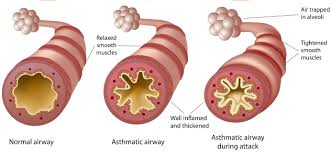A client is being treated for an acute exacerbation of asthma. Which assessment finding indicates to the nurse that the goals of treatment are being met?
The nurse observes the client using accessory muscles while breathing.
The client is able to answer questions in full sentences.
Lung auscultation demonstrates diminished breath sounds.
The client appears restless and anxious when resting in bed.
The Correct Answer is B
Choice A Reason:
Using accessory muscles while breathing is a sign of respiratory distress and indicates that the client is working harder to breathe. This is not a desired outcome of treatment and suggests that the asthma exacerbation is not under control.
Choice B Reason:
The ability to answer questions in full sentences suggests that the client's airway is not severely obstructed, which is a positive sign of effective asthma treatment. When asthma is well-controlled, individuals should not experience significant shortness of breath that limits their ability to speak.
Choice C Reason:
Diminished breath sounds can be a sign of severe airway obstruction and are not indicative of effective asthma treatment. Ideally, lung auscultation should reveal clear breath sounds without wheezing, indicating good air movement throughout the lungs.
Choice D Reason:
Restlessness and anxiety can be symptoms of hypoxia, a condition where the body or a region of the body is deprived of adequate oxygen supply. This is not a sign of effective asthma treatment and may indicate that the client's asthma is not well-managed.

Nursing Test Bank
Naxlex Comprehensive Predictor Exams
Related Questions
Correct Answer is C
Explanation
Choice A Reason
While a personality disorder can present challenges in managing medications due to the complexity of the psychiatric condition, it is not typically a contraindication for the use of alprazolam. However, caution is advised as the dynamics of personality disorders can affect medication adherence and response.
Choice B Reason
Hypertension is not a direct contraindication for alprazolam. However, since alprazolam can sometimes cause changes in blood pressure, it is important for the nurse to monitor the client's blood pressure and consult with the physician if there are concerns.
Choice C Reason
Alcohol use disorder is a significant concern when prescribing alprazolam. Alprazolam is a benzodiazepine, and concurrent use with substances like alcohol can increase the risk of respiratory depression, sedation, and misuse or addiction. Therefore, a history of alcohol use disorder should prompt the nurse to question the order and discuss alternative treatments with the physician.
Choice D Reason
Schizophrenia itself is not a contraindication for the use of alprazolam, but it is essential to consider the overall treatment plan for the client. Alprazolam is not a primary treatment for schizophrenia and is used for anxiety management. The nurse should ensure that the use of alprazolam does not interfere with the treatment of schizophrenia.
Correct Answer is D
Explanation
Choice A Reason:
Bright lighting can be overwhelming for clients experiencing perceptual alterations. While regular checks on the client's mental status are important, excessive brightness can exacerbate sensory overload. The goal is to create an environment that is calming and reduces sensory stimuli to manageable levels.
Choice B Reason:
Keeping the lights dim may help to soothe some clients, but continuous noise from a radio can contribute to sensory overload. It's crucial to tailor the environment to the individual needs of the client, which often means providing a quiet space with minimal auditory distractions.
Choice C Reason:
Having the client sit by the nurse's desk may provide necessary supervision, but it can also expose the client to high levels of activity and noise, which can be disorienting. Rest periods with the television on can be distracting and may not offer the tranquil environment needed for a client with perceptual alterations.
Choice D Reason:
Providing a well-lit room without glare or shadows and limiting noise is the most appropriate environmental change for a client with perceptual alterations. This approach helps to reduce the risk of misperceptions and hallucinations, which can be triggered by shadows and glare. A quiet and well-lit environment supports better sensory processing and helps to maintain orientation.
Whether you are a student looking to ace your exams or a practicing nurse seeking to enhance your expertise , our nursing education contents will empower you with the confidence and competence to make a difference in the lives of patients and become a respected leader in the healthcare field.
Visit Naxlex, invest in your future and unlock endless possibilities with our unparalleled nursing education contents today
Report Wrong Answer on the Current Question
Do you disagree with the answer? If yes, what is your expected answer? Explain.
Kindly be descriptive with the issue you are facing.
